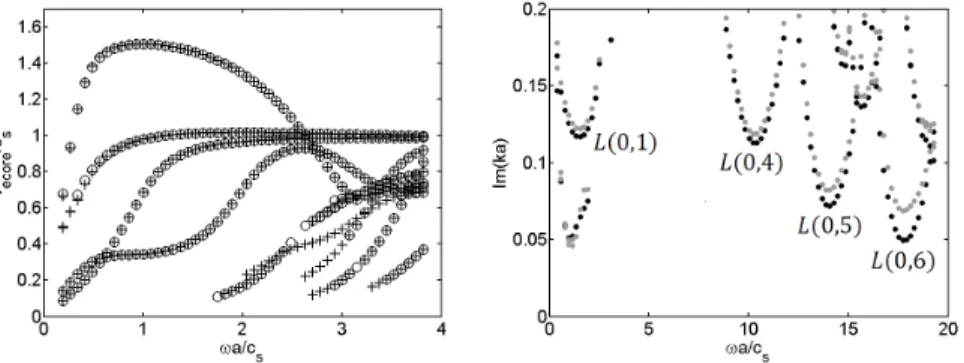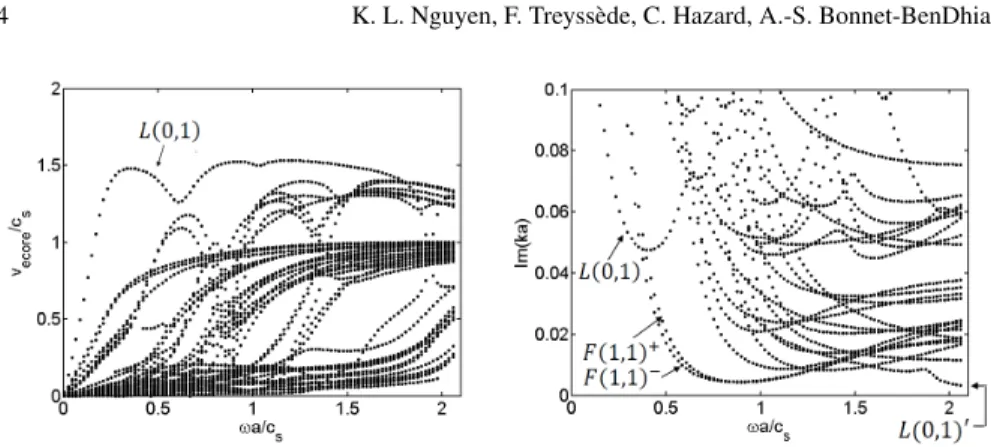HAL Id: hal-01064727
https://hal.archives-ouvertes.fr/hal-01064727
Submitted on 20 Feb 2015
HAL is a multi-disciplinary open access
archive for the deposit and dissemination of
sci-entific research documents, whether they are
pub-lished or not. The documents may come from
teaching and research institutions in France or
abroad, or from public or private research centers.
L’archive ouverte pluridisciplinaire HAL, est
destinée au dépôt et à la diffusion de documents
scientifiques de niveau recherche, publiés ou non,
émanant des établissements d’enseignement et de
recherche français ou étrangers, des laboratoires
publics ou privés.
Finite element computation of leaky modes in straight
and helical elastic waveguides
Khac-Long Nguyen, Fabien Treyssede, Christophe Hazard, Anne-Sophie
Bonnet-Ben Dhia
To cite this version:
Khac-Long Nguyen, Fabien Treyssede, Christophe Hazard, Anne-Sophie Bonnet-Ben Dhia. Finite
element computation of leaky modes in straight and helical elastic waveguides. 8th GDR Conference,
Jun 2014, GREGYNOG, France. 4p. �hal-01064727�
straight and helical elastic waveguides
K. L. Nguyen, F. Treyss`ede, C. Hazard, A.-S. Bonnet-BenDhiaAbstract Elastic guided waves are of interest for inspecting structures due to their ability to propagate over long distances. However, waveguides are often embedded in a large solid domain, considered as unbounded. The waves can attenuate strongly along the guide axis due to the energy leakage into the surrounding medium, which reduces the propagating distance. Searching modes with low attenuation becomes necessary. The goal of this work is to propose a numerical approach to compute modes in embedded elastic waveguides (straight and helical structures), combining the so-called semi-analytical finite element method (SAFE) and a perfectly matched layer (PML) method. The application of this work is the non destructive evaluation of multi-wire strands, which constitute cables in civil structures.
1 Introduction
For embedded structures, the energy leakage into the surrounding medium yields wave attenuation along the guide axis, which limits the application of guided wave technique for non destructive evaluation (NDE). An accurate determination of low leakage modes becomes necessary to maximize the inspecting range. Analytical tools have been developed to model simple geometries (plates and cylinders) [1, 2]. For complex geometries, modeling often relies on numerical approaches. A clas-sical method is the so-called semi-analytical finite element (SAFE) method restrict-ing the computational domain on the discretized waveguide cross-section. Yet, two difficulties are encountered for the numerical simulation of embedded waveguides : the unbounded cross-section and the presence of leaky modes whose amplitudes grow in transverse directions. To circumvent these difficulties, the SAFE method
K. L. Nguyen, F. Treyss`ede
IFSTTAR; Route de Bouaye, 44344 Bouguenais, France, e-mail: fabien.treyssede@ifsttar.fr C. Hazard, A.-S. Bonnet-BenDhia
ENSTA Paris Tech; 828, Boulevard des Mar´echaux, 91762 Palaiseau, France
2 K. L. Nguyen, F. Treyss`ede, C. Hazard, A.-S. Bonnet-BenDhia
has been combined with other techniques such as absorbing layer [3] and boundary element methods [4]. An alternative approach proposed in this paper is the perfectly matched layer (PML) method. A SAFE-PML approach has already been applied to model embedded solid plate waveguides in two dimensions [5].
The goal of this work is to extend this technique to model three-dimensional elastic waveguides buried in a solid matrix. First of all, the modeling of embed-ded straight waveguides is considered. The next step consists in applying the PML method in transverse twisting coordinates [6] to compute modes in embedded heli-cal structures.
2 Straight waveguides
A PML applied along the Cartesian transverse directions (X ,Y ) consists in extend-ing the elastodynamic formulation into complex coordinates ( ˜X(X ), ˜Y(Y )) to absorb waves in the surrounding medium: ˜X=RX
0 γX(ξ )dξ , ˜Y = RY
0 γY(ξ )dξ . A change of
variable is then performed to transform the formulation back to real coordinates. In addition to the PML technique, the SAFE method is applied, which assumes an eikZ
dependence, where k is the axial wavenumber and Z is the axial direction. The FE dicretization yields the quadratic eigenvalue problem :
{K1− ω2M + ik(K2− KT2) + k2K3}U = 0 (1)
Numerical results are computed for a steel bar in concrete. The eigenspectrum at a given frequency shows that the PML method not only computes physical modes (leaky) but also non-intrinsic modes (radiation modes) which depend on PML char-acteristics and resonate mainly in the PML region. In order to eliminate radiation modes, a filtering criterion is applied, defined by the ratio of kinetic energy in the PML over the kinetic energy in the whole domain. As shown in Fig. 1, dispersion curves of leaky modes are well identified after filtering. Numerical results obtained by the SAFE-PML method are in agreement with Refs. [3, 4].
3 Helical waveguides
Helical waveguides must be considered in twisting coordinates (x, y, z) defined as :
x= X cos(τZ) +Y sin(τZ), y = −X sin(τZ) +Y cos(τZ), z = Z (2)
where τ denotes the torsion of the (x, y) plane around the Z-axis.
The twisted PML method transforms twisted transverse coordinates (x, y) into complex ones ( ˜x(x), ˜y(y)). Similarly to the previous section, a twisted SAFE-PML approach can then be applied.
3.1 Validation
Since a twisted cylinder remains a cylinder, this test case can be considered to vali-date the twisted SAFE-PML method.
The comparison between the axial wavenumbers computed in both coordinate systems (with twist and without) shows that the wavenumbers of compressional and torsional modes are unchanged while those of flexural modes are translated by ±τm in the twisting system, where m denotes the circumferential order (details in [6]).
Although the axial wavenumbers are different in twisting and straight coordi-nates, the physics of cylindrical modes are left unchanged. Figure 1 shows the agree-ment between the energy velocities in both coordinate systems.
Fig. 1 Energy velocity for an embedded cylin-drical bar obtained by SAFE-PML (circles) and twisted SAFE-PML (crosses) methods.
Fig. 2 Attenuation of modes in an embedded helical wire (black) and in an embedded cylin-drical bar (gray).
3.2 Examples
Two examples of embedded helical waveguides are now considered : a steel helical wire and a steel seven-wire strand buried in concrete.
Figure 2 compares the axial attenuation of compressional L(0, n) modes in an embedded helical wire with those of an embedded cylindrical bar. This comparison concentrates on compressional modes, which have low attenuations and high en-ergy velocities. Compressional modes are more attenuated in a helical wire than in a straight one. This difference becomes more significant for high order modes. This result shows that the curvature of helical wires reduces the wave propagation dis-tance and can make their NDE more difficult. This phenomenon has been observed for other kinds of curved waveguides [7].
The dispersion curves of energy velocity for a steel seven-wire strand in con-crete is given by Fig. 3. The strand consists of one cylindrical bar surrounded by six
4 K. L. Nguyen, F. Treyss`ede, C. Hazard, A.-S. Bonnet-BenDhia
Fig. 3 Energy velocity of an embedded seven-wire strand.
Fig. 4 Attenuation of modes in an embedded seven-wire strand.
helical wires. Comparing with the results of a free strand [6], the modal behaviour is strongly modified due to the introduction of the surrounding medium. The wave attenuation is shown in Fig. 4. F(1, 1)±and L(0, 1)0modes have the lowest atten-uations in the frequency range [0, 1.5] and [1.5, 2] respectively, which may be of interest for NDE. In addition to the attenuation due to the energy leakage, the sur-rounding medium has the other effect to make helical wires almost in contact, which further modifies the dispersion curves.
References
1. M. J. S. Lowe: Plate waves for the NDT of diffusion bonded titanium, PhD Thesis Mechanical Engineering Department, Imperial College London, 1992.
2. B. Pavlakovic: Leaky guided ultrasonic waves in NDT, PhD Thesis Mechanical Engineering Department, Imperial College London, 1998.
3. M. Castaings, M. Lowe: Finite element model for waves guided along solid systems of ar-bitrary section coupled to infinite solid media, Journal of the Acoustical Society of America, 123(2), 696-708, 2008.
4. M. Mazzotti, I. Bartoli, A. Marzani, E. Viola: A coupled SAFE-2.5D BEM approach for the dispersion analysis of damped leaky guided waves in embedded waveguides of arbitrary cross-section, Ultrasonics, 53(7),1227-1241,2013.
5. F. Treyss`ede, K. L. Nguyen, A. S. Bonnet-BenDhia, C. Hazard: On the use of a SAFE-PML technique for modeling two dimensional open elastic waveguides, Acoustic, Nantes France, 667-672, April 23-27, 2012.
6. F. Treyss`ede, L. Laguerre: Investigation of elastic modes propagating in multi-wire helical waveguides, Journal of Sound and Vibration, 329, 1702-1716, 2010.
7. M. D. Beard: Guided wave inspection of embedded cylindrical structures, PhD Thesis Impe-rial College of Science, Technology and Medecine, University of London, 2002.

